Genre: Action Developer: Shin-Nihon Laser Soft Co. Publisher: Renovation Players: 1 Released: 1992
Ah yes… Valis! The fantasy story of a Japanese schoolgirl destined to save a fantasy world-/dreamland by brandishing a sword and wearing skimpy (and not at all sensible) armor. Back in the day, due to a combination of great storytelling during gameplay and a copious amount of fan service, Valis was a rather successful series of action platformers that captured the imagination of many a young gamer ( as well as their libido, which eventually – and sadly enough – culminated in an official hentai version published by the original creators. Talk about raping memories). Anyway, many Genesis gamers of the early nineties were puzzled by the release history of the games: In 1991, both the original Valis: The Fantasm Soldier (first published in 1986 on the MSX) and the newest entry Valis III, which saw its premiere the year before on the PC Engine, received a graphical overhaul and were released on Sega’s 16-bit console. But whatever happened to Valis II?, the western audience wondered. Did they leave it out completely? Well, the answer is no. In a roundabout way, the second entry in the series was released the following year and came to the US under the strange name of Syd of Valis.
That name is the result of a clash of cultures and poor translation skills. The original name of the game was SD Valis, which was a toned down remake of sorts of Valis II, which was released on MSX and PC-Engine CD. SD stands for “Super Deformed.” In Japanese culture, characters drawn in SD get a childlike, cutesy appearance with a small and chubby body, huge heads and exaggerated expressions and mannerisms. SD is usually used to convey silliness, cuteness and humor. To western observers, especially ones that aren’t very familiar with Manga or Anime (as most westerners were in the early nineties), these notions were lost. Applying cutesy, childlike looks, and silly humor to a dark fantasy tale filled with skimpy outfits and fanservice shots seems… well, rather odd. And this isn’t the only thing that (literally) got lost in translation. At some point during the western localization of the game, the people responsible must either have been afraid that no one would understand the whole SD concept, or they were confused about the idea itself. This resulted in the U.S. title Syd of Valis, with Syd being applied to the heroine of the game, the wielder of the Valis sword (who in the Japanese original, as well as in all the other Valis games, is called Yuko). Interestingly enough, this was the only name change, as all the other characters and places have retained their original titles. Confused yet? Well, we’re only getting started!
So what’s the story? Well, judging from the games intro, it goes like this: one day, our heroine Syd/Yuko is walking down the street, carrying an ice cream cone (no, really), when suddenly a strange warrior called Megas appears. He challenges her to hand over the Valis sword and, after some veiled threats, disappears again. So Syd/Yuko raises her ice cream cone in the air, which turns into the Valis sword (no, REALLY!). And thus the game begins. Already this has some weird implications. If the sword is disguised as an ice cream cone, does that mean that Syd/Yuko is carrying around that ice cream cone at all times? Does she ever lick the sword when it’s in dessert form? Does she actually consume the sword, or is it some sort of frozen dairy variety of an everlasting gobstopper? I’m putting too much thought into this, aren’t I?
Well anyway, the game. As I already mentioned, this title is derived from Valis II, and as such, the basic premise is the same: You take on the role of the Valis warrior in order to save the fantasy realm of Vecanti. Only this time, graphics and gameplay were immensely toned down. Everything now has a certain childlike appearance (due to it receiving the SD treatment), and the entire roster of characters and monsters look like characters from a Saturday morning cartoon aimed at little kids. Characters have large, googly eyes, huge heads (and, by comparison, small torsos) et cetera. Even the color scheme is very cartoony and bright, and bears little to no resemblance to the dark, moody scenarios of the other Valis games. The whole appearance is very “kiddy,” but at the same time, the characters are very huge, so it’s apparent that the target audience for this game isn’t the usual Valis fanbase, but rather children. The large sprite size turns out to be problematic though, as it leaves little room for your character to maneuver when enemies are onscreen.
The controls are very basic (C is for jumping, B for attacking, and A fires off a limited, smart bomb-like effect that clears the screen as long as there aren’t any bosses around), and the level design has been streamlined into a very straightforward affair. No diverging paths, little to no variety in gameplay; Just run straight on until you reach the end of the level. However, the gameplay design is pretty flawed. For example, the screen only advances if your protagonist moves to the far side of the screen. Due to the size of the characters however, this increases the danger of straight on running into an unseen enemy suddenly popping up. This is made even worse due to the games horrible collision detection. Sometimes you even take damage BEFORE actually touching a foe. And jumping sections (of which there is precisely one) turn into a chore, because the jumping physics are extremely floaty and your heroines movements have quite a momentum to them, which more often than not leads to overshooting the target when pinpoint jumping is necessary. Also, upon a hit Syd/Yuko isn’t just knocked back, she’s practically catapulted into the air, which can be a death sentence in itself if you drop into a lava pit. You drop down, take damage, are thrown in the air, and before you can attempt to jump back out, you drop down and take damage again… until you run out of energy.
The game designers apparently decided to offset this exercise in frustration by toning down the difficulty as well. By which I mean to say the game is piss-easy! Syd/Yuko keeps attacking as long as you keep the B-Button pressed down, so if you just keep running to the right (and occasionally left) and hold down the attack, you’ll reach the end of each (incredibly short) level in no time! At some point during the stage (not always at the end, mind you, but sometimes somewhere in the middle) a boss fight awaits you. These usually are also so simple it’s laughable. The boss patterns are very simple and limited (like slowly shuffling forward, punch, slowly shuffling backwards, shoot, repeat), and figuring out how to defeat them usually takes no effort at all. Most bosses even have blind spots that they never (or only very occasionally) hit, so you just need to stand still, hold down B and wait until the battle resolves itself (worst of all, this also applies to the final boss!). As a countermeasure, some bosses have multiple forms, or they take three to four hits until they lose a single bar of energy, which needlessly drags battles out, as you just keep standing there and literally wait for a minute until the enemy finally is defeated. Programming has been pretty shoddy in general, since especially during boss fights there is a lot of flicker onscreen, even if there’s not all that much going on.
In order to reflect some sort of character progression, at certain points in the game Syd/Yuko gets awarded with new attacks (the basic straight shot can be replaced with a wave, homing or three-way attack) and suits of clothing which serve as armor and have different stats in terms of attack, defense or speed bonus (the first one being… a Chinese dress? What the heck?). You can switch between any form of attack or armor type in the pause menu. This could be a nice idea if it affected gameplay in any way. Most of the times though it doesn’t. standard and wave attacks become obsolete once the homing attack is unlocked, and you can easily speed through the game without changing armor at all (in my first playthrough I manually switched armor exactly once). Another feature that feels like it was only tacked on is the level-up system. Your weapons can have three different attack levels, modifying them in terms of reach and strength. However, instead of leveling up individually, or instead of having a level-up system based on how much a certain weapon is used (which would somewhat redeem the existence of wave and standard attacks), it seems like your weapons only level up at set points within the game, and when this happens, all level up at once. Interestingly enough, there are power-ups (aside from additional smart bombs, health, or lives) strewn throughout the levels which I assumed would influence the level up system for the weapons, but after repeated playthroughs it appears that those don’t do anything at all.
Overall, Syd of Valis feels like a hackneyed rush job, lazily thrown together on short notice. Poor collision detection, flickering sprites, ridiculously easy difficulty, the tacked on character progression and the odd weapon/armor/power-up system already hinted at that, but nowhere is it more obvious than in the poor translation of the game. The original story has been taken, chopped up, edited down, and softened up in the more violent parts. It’s still there but barely recognizable. That would be bad enough, but the translation itself is a horrible mess, full of redundancies, spelling errors and grammatical mistakes! Did no one proofread this thing? The laziness of it all becomes most apparent at the game over and credits screens, which haven’t been translated at all! So unless you speak Japanese and are able to read Hiragana and Katakana, you’ll never find out who’s responsible for this lazy-ass translation and programming-efforts. Syd of Valis is a disappointment for fans and non-fans alike, and unless you are looking for some sort of “my kid’s first action platformer” game, I’d suggest staying away from it. It’s like the game was created as a joke, one that the producers didn’t get but released anyway.
SCORE: 2 out of 10


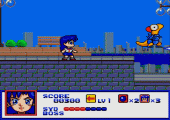
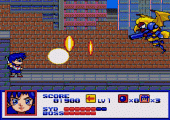
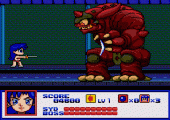
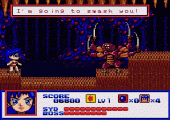
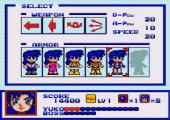
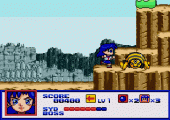
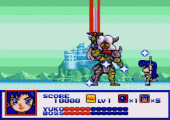
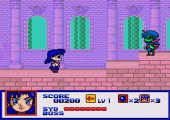
Recent Comments